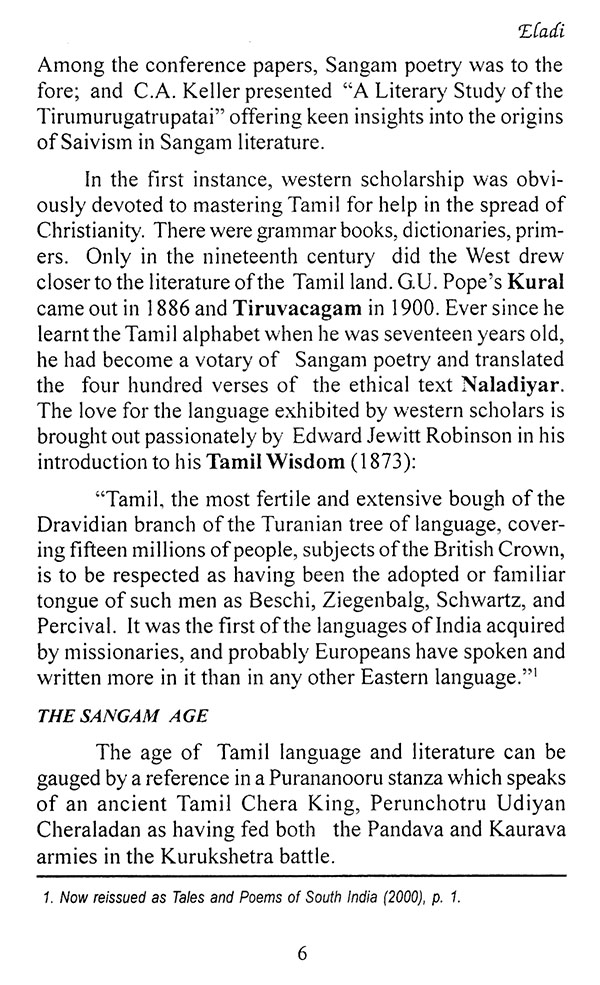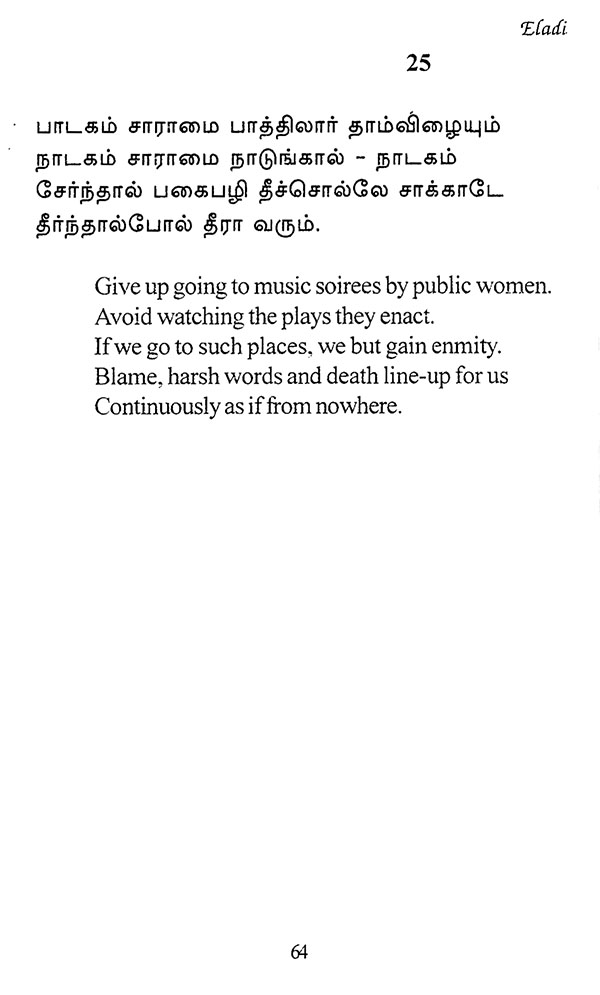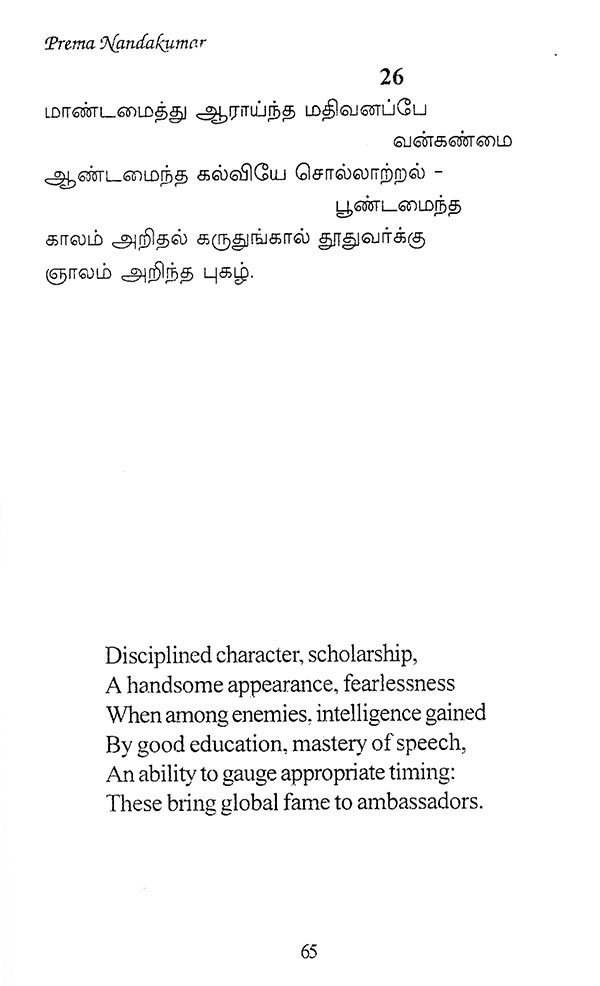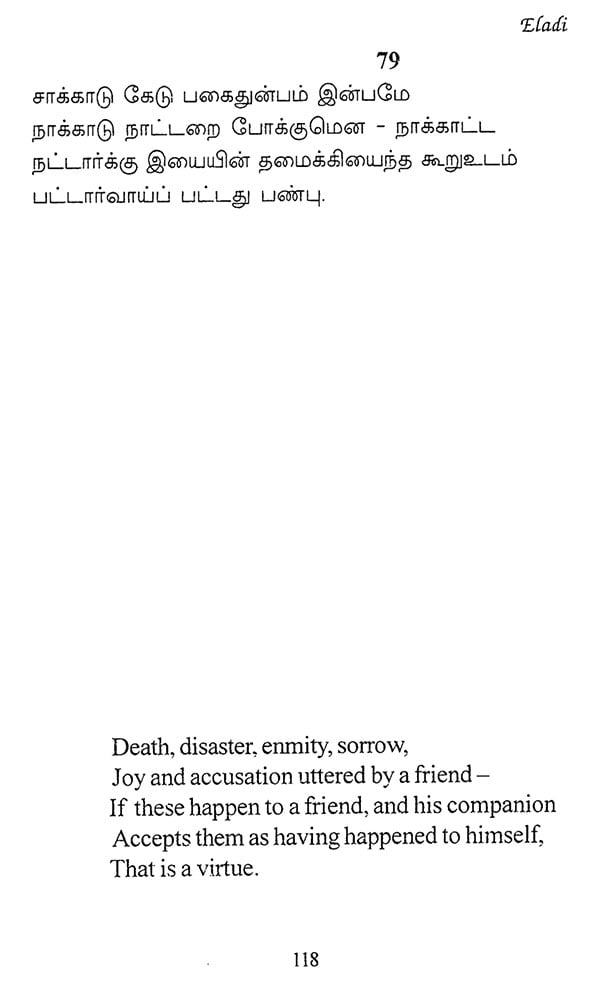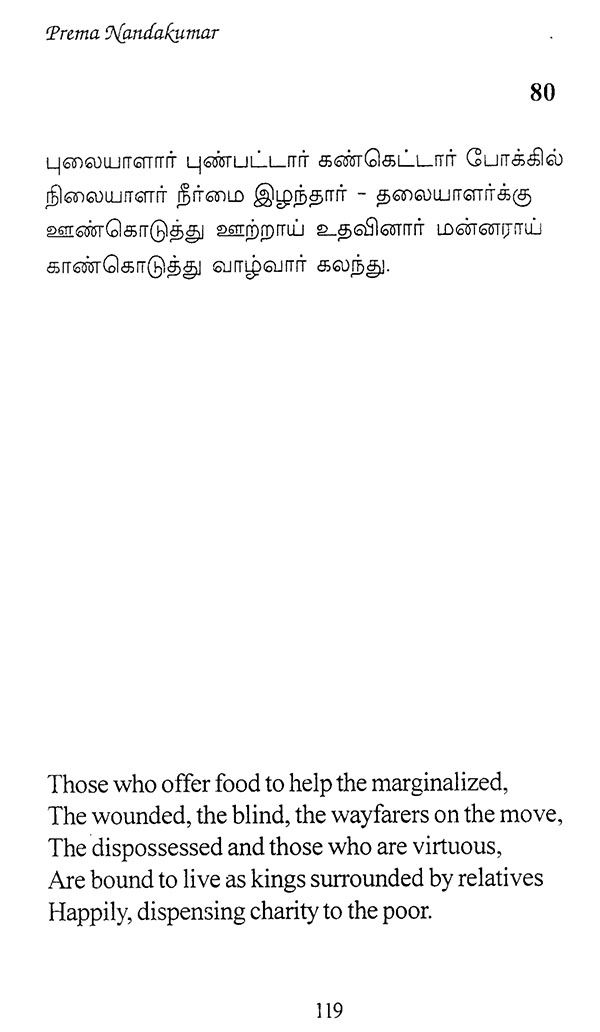
Eladi (Tamil Classic by Ganimedhaiar)
Book Specification
| Item Code: | NAX149 |
| Author: | Prema Nandakumar |
| Publisher: | Dravidian University Campus |
| Language: | Tamil and English |
| Edition: | 2007 |
| Pages: | 122 |
| Cover: | PAPERBACK |
| Other Details | 7.00 X 5.00 inch |
| Weight | 110 gm |
Book Description
That the foundations of Indian culture were deeply imbedded in Dravidian culture is now an incontrovertible fact. Dravidian culture is one of the most ancient cultures of the world. Those cultures, slightly contemporaneous to one another, slowly started fading out. However, the primordial Dravidian culture continues to thrive without losing its quintessence despite the apparent changes in systems of dress and address.
Dravidian University was established in 1997 to mirror the real and rich picture of Dravidian culture not only in its linguistic, literary, cultural and philosophical facets but in science and tech- nological angles also.
At atime when no special attention worth its name was paid by the Centre with regard to language, the Southern states except Kerala, had established all by themselves their own Universities - Telugu, Tamil and Kannada - to research on their languages and cultures.
The Government of Andhra Pradesh took a step ahead and started Dravidian University, with the co-operation of the sister states, to research and reflect on the inherent oneness of the cultures of the four states whose languages number up to 27. Its endeavour is to promote unity and amity in the family of several languages. The main objectives of Dravidian University are to augment the common weal and social well being of the communities of marginal languages and to build bridges among the Southern states. While working on each language separately in varied areas, it aims at a synthesis and a discovery of the common heritage through Comparative Studies.
Prasaranga and Anusrjana (Translation Bureau) are the two most significant wings of the University from out of its several on going progressive activities.
The end of Sangam literary trend produced a surging ethi- cal literature in Tamil. This includes the famous Tirukkural, Naladiyar and such other ethical literatures. The third part of Tirukkural, called Kamatuppal, of course, shows that there re- mains a continuity as kamatuppal is an extension and develop- ment of the Sangam literary theme, Akham. Otherwise Tirukkural would not have included Kamatuppal as an integral part of the text because the aim of Tirukkural was to write about ethics.
This surge of ethical literature on to the Tamil literary scene perhaps puts an end to the Sangam tradition and paves the way for the emergence of a different stage of literary tradition thereafter. This new tradition of literature characterized by some critics as a less significant one compared to the glorious tradition of Sangam literature is known to Tamil Students of literary history as Kizhkanakku.
Eladi belongs to this group of literary texts called Kizhkanakku and these are eighteen in number, the names of which are given by Prema Nandakumar in her Introduction to this book.
Eladi belongs to the Jain tradition of Tamil literature. This book contains largely aphorisms meant to be addressed to Jains; but they are of universal value to the entire human kind. Most of these verses use a second person method of addressing a woman called mahadumunnilai. Majority of these use this method of address to convey wise instructions. Over and above these precepts, two main ideas- ‘Renunciation’ and ‘Realisation’ predominate the theme of Eladi.
Dravidian University is grateful to Dr. Prema Nandakumar for her brilliant translation of an ancient Tamil ethical text with a lasting value. The other facet of ethics is culture. The modern word needs the practice of culture along with the preaching of ethics.
A very rich portion of Indian literature and culture comes from the Dravidian areas. Of the languages of South India, Tamil has the oldest extant literature going back to two thousand years and more. It is strange that this was not recognized widely even in the twentieth century. Take, for instance, the high-profile pro- duction The Hinduism Omnibus (O.U.P., 2003) which has no in- puts regarding the religion and society of the Tamil area that has arich, written tradition of literature and a history of two millen- nia. And yet, the four scholars in the omnibus present titles as if they speak of the entire Indian civilization: Nirad C.Chaudhuri (Hinduism: A Religion to Live By), Madeleine Biardeau (Hindu- ism: The Anthropology of a Civilization), D.F. Pocock (Mind, Body and Wealth: A Study of Belief and Practice in an Indian Village) and T.N. Madan (Non- Renunciation: Themes and In- terpretations of Hindu Culture)... The only reference to South India by Nirad Chaudhuri is a misstatement!
(the) control of the social, cultural. and religious life of the Hindus of the south , more especially in the Tamil country, remained in the hands of the Brahmins, who maintained it undisputed till the beginning of this century. The power of the Brahmins also meant the hold of the older and higher form of Hindu- ism, because of their knowledge of Sanskrit. Though the spoken and written mother tongue of the Brahmins was Tamil or some other language of the so-called Dravidian family, they had a knowIedge of Sanskrit which was not surpassed in the north, and was often deeper. Secular life of the region remained wholly within the framework set by Hinduism."!
Now, in ancient Tamil land, the Arasar (kshatriya) came first in all enumerations and the most powerful were probably the Vaisyas who were in charge of the economy of the land. And honour always went to the farmers as Tiruvalluvar eulogized them in his Tirukkural. Fortunately, the same twentieth century that has produced The Hinduism Omnibus has also seen a tremen- dous interest in Dravidology. A classical language that has sur- vived as a spoken medium for two thousand years and more is certainly an astonishing phenomenon. However, much yet remains to be done to introduce the ancient Tamil literature to the world. Here is significant material for reconstructing the history of South India in a big way and for introducing comparative studies for a better understanding of the Indian past that can illumine us to format our future. Translation of this sector of Indian literature is the only way in which it can be introduced to a widening reader- ship.
I was very happy when Prof. G. Lakshminarayana, Vice- Chancellor of the Dravidian University and Sri Mohan Prasad, Director of the Translation Bureau, asked me to translate a Sangam work into English for the translation program of their University. To them I owe a special word of thanks. I have been no stranger to the art of translation, having experienced all the agonies and ec- stasies of a translator for half a century! My first work in this sphere was Bharati in English Verse (1958) which contained selected poems of the great Tamil nationalist poet Subramania Bharati with an introduction. As for Sangam literature, I have been engaged in translating selected poems and passages and my trans- lation of the ancient epic Manimekalai was published by the Tamil University, Thanjavur. It is a line by line translation of the entire poem which is constructed on a Buddhist theme. A very strenuous task, but one that brought me a sense of fulfilment.
For, while translating modem Tamil into English is not very difficult, despite the cultural barrier, attempting to render into En- glish an ancient Tamil work seemed an impossible task. After all, there lay 2000 years between me and the epic’s author, Seethalai Sathanar. As I wrestled with the words, I seemed to be re-educat- ing myself on my own past stretching back to generations. It was a matter of pride that this Buddhist epic had been written in beau- tiful Tamil that still dazzles us with its unforgettable phrases and sublime thoughts.
However, translating a narrative gives a certain elbow- room for the translator in the choice of phrases but a terse work on ethics leaves little room for manipulation. Ganimethaiyar, the au- thor of Eladi sounds epigrammatic most of the time. At the same time, ethical advice is also universal. The ideal life is always a life of humanism and that is what Eladi teaches us. Ganimethaiyar wants us to care for our fellow-men and learn to welcome stern self-discipline, if we want to become achievers in life.
While more than a score of English translations can be found for Tirukkural, it is surprising that the other ethical texts of the Sangam period (Naladiyar, Nan Mani Kadikai, Iniyavai Narpathu, Tirikadukam, Pazhamozhi Nanooru, Acara-k-kovai, Muthu Mozhi Kanchi, Innilai, Eladi and Sirupanchamoolam) remain largely unknown to the outside world. Perhaps the perfect archi- tectonics of Tirukkural has something to do with this popular- ity. It must also be mentioned here that till a few decades ago, verses from all these works that insist upon moral principles were quoted often in classrooms by the teachers, and the works were also prescribed. For all these works contain an abundance of quot- able quotes, and it would be a pity if they went out of circulation. they are certainly unimpeachable textbooks for moral education in our schools and colleges.

